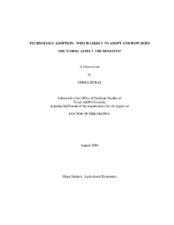| dc.description.abstract | Many fields of economics point to technology as the primary vehicle for change. Agencies pushing change often promote technology adoption to achieve their goals. To improve our understanding of how efforts to push new technologies should be focused, two studies are undertaken. The first study defines and tests for universality using meta-regression analysis on 170 analyses of agricultural production technologies. The second study, a case study on an emerging information technology - climate forecasts, examines how the timing of adoption affects the benefits.
A factor exhibiting a systematic positive or negative effect on technology adoption is a universal factor. If the impact is the same regardless of location or technology type, the factor is strongly universal. The factor is weakly universal if the impact varies by location or technology type. Education and farm size are found to be weakly positive universal, age is found to be weakly negative universal, and outreach is not found to be a universal factor in the adoption of technology. These results indicate that technology-promoters may want to change their approach and focus on younger, more educated producers with larger farms.
In the second study, an international wheat trade model incorporating climate variability is used to simulate different scenarios when wheat producers in the U.S., Canada, and Australia adopt ENSO-based forecasts for use in production decisions. Adoption timing and levels are varied across countries in the different scenarios. The results are highly consistent. Early adopters benefit the most, there is no incentive for more producers to adopt after 60% to 95% have adopted (meaning the adoption ceiling has been reached), and slower adoption corresponds to ceilings closer to 60% than 95%.
Examining technology adoption from two angles provides a deeper understanding of the adoption process and aids technology-promoters in achieving their goals. In addition to focusing on younger, more educated producers with larger farms, technology-promoters wanting wide-spread adoption with high benefits need to push constituents to adopt early and fast. | en |


